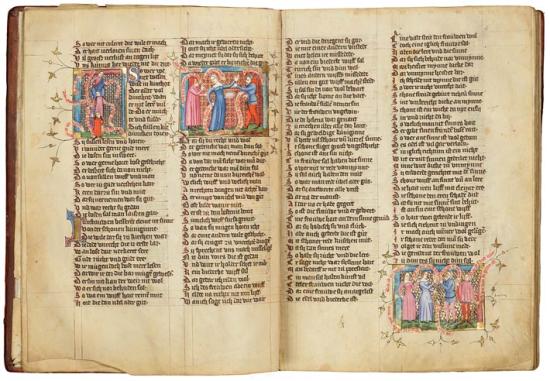
Der Wälsche Gast, in German
Illuminated by the Kuno von Falkenstein workshop
Gift of the Trustees of the William S. Glazier Collection, 1984
The women in this allegorical treatise wear cotes hardy similar to their French contemporaries (albeit on slightly plumper figures). Their loose skirts contrast with tight bodices, bosoms, and sleeves, the ends of which are slightly funnel shaped. In the second miniature at the left, the young male personification of Bad Advice wears a wasp-waisted, stuffed doublet. His pouleines (pointed shoes) are particularly elegant with open fretwork. In the miniature at the right the older male personification of Irrationality is similarly dressed. Behind him, the young male Seducer wears a dashing pink paltock (a loose jacket with sleeves) over his doublet.
Wasp Waists and Stuffed Shirts
The second half of the fourteenth century was a bleak period in French history. The Black Plague, which first struck in 1348, was a recurring horror. As the Hundred Years' War dragged on, France suffered devastating defeats by the English. Following the Battle of Poitiers in 1356, King John II was captured and taken to London as a prisoner. Fashions changed little during this period.
Men's fashion was dominated by the pourpoint: a close-fitting doublet influenced by the military. With a short flaring skirt and a cinched waist, the pourpoint was padded at the chest and shoulders, giving its wearer a distinctive hourglass silhouette. Pouleines, long pointed shoes, and belts—slender, or the thick "Bohemian" girdle—worn low on the hips complimented the look.
The cote hardy—an outer garment for women—while retaining its voluminous skirt, got even tighter at the bodice, bosom, and sleeves. The resulting look paralleled that of men's fashion. Tippets, decorative strips of cloth hanging from the arms, remained popular. Both men and women continued to wear the chaperon (the hood with attached cape and tail).
